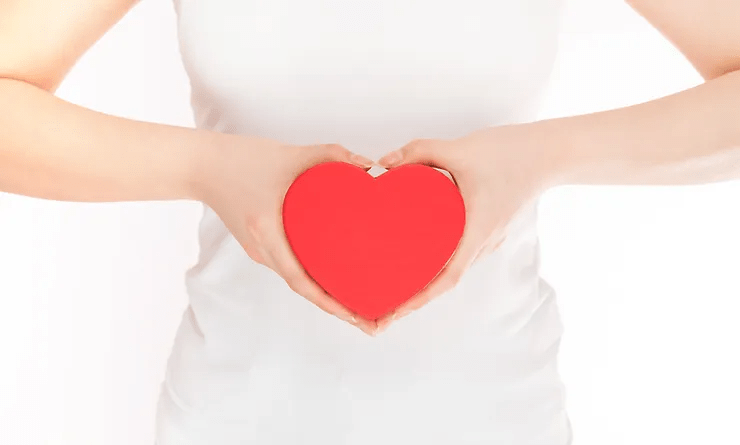How to Lower Your Cholesterol Naturally – 10 Tips to Get Started
February 8, 2022

If your cholesterol has been creeping up over the past few years and you’re ready to take control of your heart health, try some of the strategies below!
Many think of cholesterol as something that is unhealthy. However, cholesterol plays an important role in various functions in the body. It is a component of bile which is used for the digestion of dietary fat, it is used to make hormones (including vitamin D), and it is a part of the outer membrane of our cells. Our liver produces cholesterol and we can obtain it from the foods we eat. Cholesterol is only found in animal-based foods such as beef, poultry, pork, eggs, and dairy foods. Consuming cholesterol from food is not required because our body can produce all it needs.
About 38% of Americans have high cholesterol!
While we need cholesterol for functions in our body, too much cholesterol can increase our risk for heart disease. You are likely aware of the different types of cholesterol present in the blood, including HDL (or “good” cholesterol) and LDL (or “bad” cholesterol). HDL cholesterol is considered good because it helps remove LDL cholesterol from the body. LDL cholesterol is considered bad because it contributes to plaque formation in the arteries leading to hardening of the arterial walls (atherosclerosis).
Here’s the good news…
If you have an elevated total or LDL cholesterol, or a low HDL cholesterol, there are lifestyle strategies that can improve, or even reverse those levels. The impact of lifestyle strategies can be quite significant, particularly if you implement multiple strategies to bring your blood lipids back towards the normal range.
10 tips to get you started on a path towards healthier cholesterol levels:
1. Initiate a healthy weight loss program if you are overweight.
Weight loss has a significant impact on reducing elevated blood lipid levels. Losing weight has been shown to lower total cholesterol, LDL cholesterol, and triglycerides while raising HDL (“good”) cholesterol. Even modest amounts of weight loss (5-10% body weight) can make a significant improvement in blood lipids.
2. Eat plenty of fiber, particularly soluble fiber found in oats, fruits, vegetables, and legumes.
Most Americans consume less than 10 grams of fiber daily when we should be eating 25-35 grams per day. Gradually increase your fiber intake while drinking plenty of water (8 cups/day minimum). Soluble fiber can help reduce total and LDL cholesterol and triglycerides.
3. Reduce saturated fat intake.
Sources of saturated fat include high-fat cheeses, beef, dark meat poultry, skin-on poultry, processed meat, whole-fat milk, cream, butter, ice cream, and palm oil. Reducing saturated fat can help reduce total and LDL cholesterol and triglycerides.
4. Eliminate trans fatty acids.
Trans fats are found in fried foods and processed foods such as packaged crackers, cookies, cakes, doughnuts, and pies. Read ingredients on labels and avoid “hydrogenated oil” or “partially hydrogenated oil.” Trans fats are the worst types of fats for your health because they increase LDL cholesterol and triglycerides while lowering HDL cholesterol.
5. Avoid or limit alcohol.
Consuming alcohol at levels greater than what is considered a “moderate intake” can contribute to elevated cholesterol and triglycerides in the body. Moderate alcohol intake is considered 1 or less drinks/day for women and 2 or less drinks/day for men.
6. Increase intake of unsaturated fats.
Monounsaturated and polyunsaturated fats have an anti-inflammatory effect and are considered heart healthy due to their favorable effect on blood lipid levels. They are found in olives and olive oil, flaxseeds and flax oil, avocado oil, nuts, seeds, and fish (salmon, mackerel, herring, albacore tuna, and rainbow trout are high in omega-3 fatty acids).
7. Sip on green tea.
Drinking at least one cup daily can reduce total and LDL cholesterol. Drinking up to 4 cups daily has an even greater impact. (Go for decaf with higher tea intake).
8. Include physical activity in your lifestyle.
With your doctor’s approval, work up to at least 30 minutes of moderate intensity exercise 5 days per week. Exercise has been shown to increase HDL cholesterol.
9. Incorporate stress management techniques daily.
Chronic stress may increase cholesterol levels.
10. Improve your gut microbial balance.
Certain gut bacteria play a role in cholesterol metabolism by breaking down cholesterol in the intestines for excretion. If you lack these groups of bacteria, then you may not be excreting as much cholesterol from your body as you could with a healthier microbial balance. Include probiotic foods such as yogurt, kefir, miso, and sauerkraut along with prebiotic foods such as garlic, onions, avocado, and other fruits and vegetables to enrich your gut microbiome.
Whenever you begin a lifestyle change, start with small achievable goals. Do not try to tackle all strategies at once because you may become overwhelmed. If you don’t know where to begin in your lifestyle program to improve your cholesterol levels, consult a Registered Dietitian Nutritionist who can help you develop a plan that works for you.
References:
Virani SS, Alonso A, Aparicio HJ, Benjamin EJ, Bittencourt MS, Callaway CW, et al. Heart disease and stroke statistics—2021 update: a report from the American Heart Association. Circulation. 2021;143:e254–e743.
Schade DS, Shey L, Eaton RP. Cholesterol Review: A Metabolically Important Molecule. Endocr Pract. 2020 Dec;26(12):1514-1523. doi: 10.4158/EP-2020-0347. PMID: 33471744.
Feingold KR. Obesity and Dyslipidemia. 2020 Nov 2. In: Feingold KR, Anawalt B, Boyce A, Chrousos G, de Herder WW, Dhatariya K, Dungan K, Hershman JM, Hofland J, Kalra S, Kaltsas G, Koch C, Kopp P, Korbonits M, Kovacs CS, Kuohung W, Laferrère B, Levy M, McGee EA, McLachlan R, Morley JE, New M, Purnell J, Sahay R, Singer F, Sperling MA, Stratakis CA, Trence DL, Wilson DP, editors. Endotext [Internet]. South Dartmouth (MA): MDText.com, Inc.; 2000–. PMID: 26247088.
Soliman GA. Dietary Fiber, Atherosclerosis, and Cardiovascular Disease. Nutrients. 2019 May 23;11(5):1155. doi: 10.3390/nu11051155. PMID: 31126110; PMCID: PMC6566984.
Hooper L, Martin N, Jimoh OF, Kirk C, Foster E, Abdelhamid AS. Reduction in saturated fat intake for cardiovascular disease. Cochrane Database Syst Rev. 2020 May 19;5(5):CD011737. doi: 10.1002/14651858.CD011737.pub2. Update in: Cochrane Database Syst Rev. 2020 Aug 21;8:CD011737. PMID: 32428300; PMCID: PMC7388853.
Oteng AB, Kersten S. Mechanisms of Action of trans Fatty Acids. Adv Nutr. 2020 May 1;11(3):697-708. doi: 10.1093/advances/nmz125. PMID: 31782488; PMCID: PMC7231579.
Xu R, Yang K, Li S, Dai M, Chen G. Effect of green tea consumption on blood lipids: a systematic review and meta-analysis of randomized controlled trials. Nutr J. 2020 May 20;19(1):48. doi: 10.1186/s12937-020-00557-5. PMID: 32434539; PMCID: PMC7240975.
Fragala MS, Bi C, Chaump M, Kaufman HW, Kroll MH. Associations of aerobic and strength exercise with clinical laboratory test values. PLoS One. 2017 Oct 23;12(10):e0180840. doi: 10.1371/journal.pone.0180840. PMID: 29059178; PMCID: PMC5653181.
Tang WH, Kitai T, Hazen SL. Gut Microbiota in Cardiovascular Health and Disease. Circ Res. 2017 Mar 31;120(7):1183-1196. doi: 10.1161/CIRCRESAHA.117.309715. PMID: 28360349; PMCID: PMC5390330.
Kenny, Douglas J et al. “Cholesterol Metabolism by Uncultured Human Gut Bacteria Influences Host Cholesterol Level.” Cell host & microbe vol. 28,2 (2020): 245-257.e6. doi:10.1016/j.chom.2020.05.013

Lisa Kirkman is a Registered Dietitian and Functional Nutritionist who helps people move beyond treating symptoms and resolve their health challenges. Using advanced functional lab testing and evidence-based practices, Lisa and her clients team up to resolve underlying imbalances, heal the gut, and restore vibrant whole-body health.
Can’t Eat Without Bloating?




